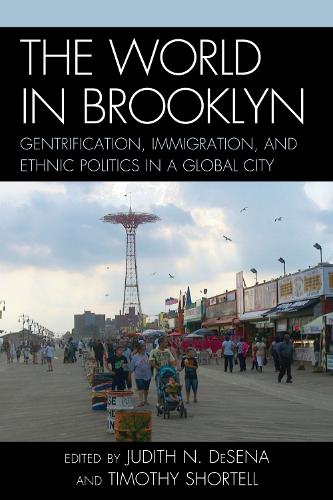
The World in Brooklyn: Gentrification, Immigration, and Ethnic Politics in a Global City
(Paperback)
Publishing Details
The World in Brooklyn: Gentrification, Immigration, and Ethnic Politics in a Global City
By (Author) Judith DeSena
Contributions by Noel S. Anderson
Contributions by Alessandro Bus
Edited by Timothy Shortell
Contributions by Evrick Brown
Contributions by Jennifer Candipan
Contributions by Phyllis Conn
Contributions by Roberta Cordeau
Contributions by William DiFazio
Contributions by Shanna Farrell
Bloomsbury Publishing PLC
Lexington Books
10th December 2013
United States
Classifications
Professional and Scholarly
Non Fiction
Ethnic studies / Ethnicity
Migration, immigration and emigration
307.760974723
Physical Properties
Paperback
430
Width 151mm, Height 225mm, Spine 26mm
685g
Description
The World in Brooklyn: Gentrification, Immigration, and Ethnic Politics in a Global City, is a collection of scholarly papers which analyze demographic, social, political, and economic trends that are occurring in Brooklyn. Brooklyn, as the context, reflects global forces while also contributing to them. The idea for this volume developed as the editors discovered a group of scholars from different disciplines and various universities studying Brooklyn. Brooklyn has always been legendary and has more recently regained its stature as a much sought after place to live, work and have fun. Popular folklore has it that most U.S. residents trace their family origins to Brooklyn. It is presently referred to as one of the hippest places in New York. Thus, this book is a collection of demographic, ethnographic, and comparative studies which focus on urban dynamics in Brooklyn. The chapters investigate issues of social class, urban development, immigration, race, ethnicity and politics within the context of Brooklyn.
As a whole, this book considers both theoretical and practical urban issues. In most cases the scholarly perspective is on everyday life. With this in mind there are also social justice concerns. Issues of social segregation and attendant homogenization are brought to light. Moreover, social class and race advantages or disadvantages, as part of urban processes, are underscored through critiques of local policy decisions throughout the chapters. A common thread is the assertion by contributors that planning the future of Brooklyn needs to include multi-ethnic, racial, and economic groups, those very residents who make-up Brooklyn.
Reviews
Mobility defines Brooklyn, a place of arrival and aspiration. Waves of immigrants have shaped and reshaped the borough's neighborhoods; gentrifiers have discovered and revived its brownstone-lined streets, recreating value destroyed by periods of municipal divestment. In this sense, Brooklyn is more like other cities than not. This edited volume balances these universal, generalizable aspects with particular historical-geographical perspectives on Brooklyn's diversities. The second chapter analyzes demographic trends, using maps to show where various ethnic groups have settled over the past decade. The following chapters effectively use case studies to examine gentrification, productions of space, and politics. Oft-examined neighborhoods such as Coney Island and Williamsburg are included, as well as less familiar places such as Canarsie and Sunset Park. Unique perspectives on places, such as education politics in Fort Greene and the visual semiotics of immigrant retail landscapes, add interest. Chapters are uniformly well written, with clear literature reviews that establish theoretical frameworks supported by ethnographic fieldwork, interviews, statistics, and other forms of qualitative and quantitative data. This attention to method makes this collection particularly well suited for use in a variety of courses. Many illustrations, graphs, and tables enhance an already lively text. Summing Up: Highly recommended. * Choice Reviews *
Judith N. DeSena and Timothy Shortell have produced an invaluable compendium of original essays about Brooklyns changing social worlds. Their book is a must read for anyone concerned with urban change and social justice. They also prove that Thomas Wolfe was wrong: not only the dead know Brooklyn. These essays by highly dedicated, living scholars capture the joys and struggles of life in the nations greatest borough. -- William Kornblum, Emeritus Professor of Sociology, Graduate Center, CUNY
DeSena and Shortell bring together a stellar cast of scholars who use demographic, ethnographic, and comparative data to offer a fresh perspective on race, ethnicity and class in Brooklyns changing neighborhoods. It is a must-read for anybody interested in understanding gentrification and growing inequality after the Great Recession. -- Bruce Haynes, University of California, Davis
Author Bio
Judith N. DeSena is professor of sociology at St. John's University.
Timothy Shortell is director of the MA program in sociology at Brooklyn College.
